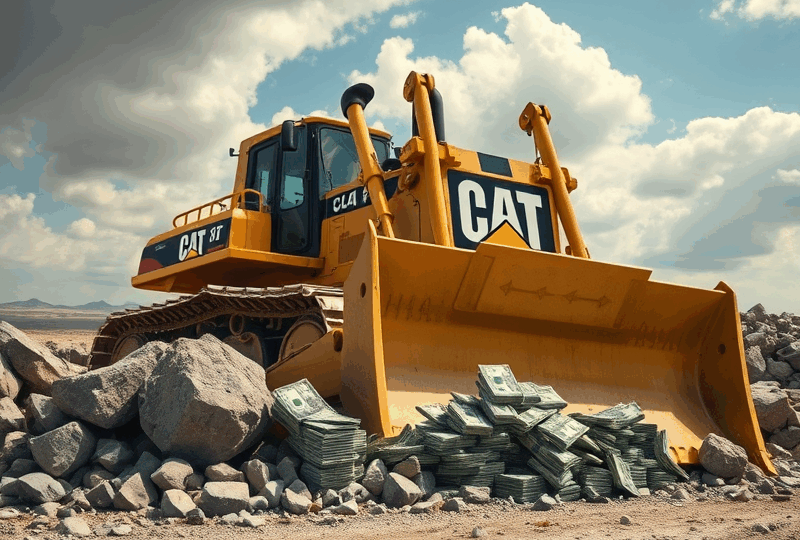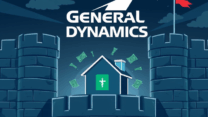
Caterpillar (CAT) Stock: Is This Industrial Giant Poised for Massive Growth?

Hello, fellow investors and observers of global industry! When you think of massive, powerful machinery shaping the world around us – building roads, extracting resources, powering industries – one name often comes to mind: Caterpillar. With its iconic yellow equipment seen on construction sites and in mines across the globe, Caterpillar Inc. (CAT) is a true industrial giant. As a company deeply tied to the fundamental activities of building and extracting, its performance is often seen as a barometer for the health of the global economy. Given its scale and its connection to essential global needs, you might wonder, “Can a company this big still achieve massive growth?” or “With all the talk of infrastructure spending and resource demand, is Caterpillar stock poised for significant expansion right now?” You’re asking questions that get to the heart of investing in large, established industrial leaders! The purpose of this article is to take a friendly, in-depth look at Caterpillar (CAT) stock, exploring what drives its business, the factors that could fuel its growth, the challenges it faces, and what investors should consider when evaluating its potential. Let’s explore whether this industrial powerhouse is indeed poised for massive growth and what that might mean for your investment portfolio.
Caterpillar: An Industrial Powerhouse
Caterpillar Inc. is the world’s largest manufacturer of construction and mining equipment, diesel and natural gas engines, industrial gas turbines, and diesel-electric locomotives. Founded in 1925, the company has a long and rich history, building a reputation for durability, reliability, and innovation in heavy machinery. Headquartered in Irving, Texas, Caterpillar operates globally, with manufacturing facilities, dealerships, and customers in virtually every corner of the world. Its equipment is essential for a wide range of activities, from building roads, bridges, and buildings to extracting minerals and energy resources, and providing power generation solutions. Caterpillar’s business is deeply cyclical, meaning its sales and profitability are heavily influenced by the ups and downs of the global economy, particularly activity in the construction, mining, and energy sectors. Understanding this cyclical nature is fundamental to evaluating the company and its stock.
Understanding Caterpillar’s Core Business Segments
Caterpillar’s operations are organized into several primary business segments, each contributing to its overall revenue and reflecting different parts of the global industrial economy:
- Construction Industries: This is typically Caterpillar’s largest segment. It produces machines for infrastructure and building construction, including backhoe loaders, dozers, excavators, skid steer loaders, and wheel loaders. Sales in this segment are driven by residential, non-residential, and infrastructure construction activity globally. Government spending on infrastructure projects is a key driver for this segment.
- Resource Industries: This segment focuses on equipment used in mining, quarrying, and aggregates, as well as heavy construction. Products include large mining trucks, excavators, draglines, and drills. Demand in this segment is closely tied to global commodity prices (like copper, iron ore, coal, gold) and the capital spending of mining companies. When commodity prices are high, mining companies tend to invest more in new equipment to increase production.
- Energy & Transportation: This segment manufactures engines, turbines, and locomotives. It serves a diverse range of industries, including oil and gas (engines and turbines for drilling, production, and transportation), power generation (engines and turbines for electric power), industrial applications (engines for various manufacturing processes), and transportation (locomotives and related components). Demand in this segment is influenced by activity in the energy sector, global electricity demand, and transportation infrastructure needs.
- Financial Products: This segment provides financing and related services to customers and dealers who purchase Caterpillar equipment. This includes retail and wholesale financing, as well as insurance. This segment supports the sales of the other segments and provides a source of recurring income.
Analyzing the performance and outlook for each of these segments provides a clearer picture of Caterpillar’s overall business health and potential growth drivers.
Potential Drivers for Significant Growth
While “massive growth” for a company the size of Caterpillar (which already generates tens of billions in revenue) might mean something different than for a small startup, there are indeed powerful global trends and factors that could fuel significant, sustained growth for the company in the coming years:
- Global Infrastructure Spending: Many countries, including the United States, have recognized the critical need to upgrade aging infrastructure (roads, bridges, ports, utilities) and invest in new infrastructure to support future economic growth. Government stimulus packages and long-term infrastructure plans around the world represent a potentially massive source of demand for Caterpillar’s construction equipment. This isn’t just a short-term boost; infrastructure needs are long-term.
- Growth in Emerging Markets: Developing and emerging economies continue to urbanize and industrialize. This process requires significant investment in infrastructure, housing, and resource extraction to support growing populations and economies. Caterpillar has a strong presence in many of these markets, and continued development there can drive substantial demand for its equipment.
- Strong Commodity Demand: The global transition towards cleaner energy (which requires minerals like copper and lithium), coupled with ongoing demand from industrialization, could keep commodity prices relatively strong. Sustained high commodity prices incentivize mining companies to invest in new equipment to increase production, directly benefiting Caterpillar’s Resource Industries segment.
- Energy Sector Investment: While there’s a global shift towards renewables, traditional energy sources like natural gas and oil will likely remain important for decades. Investment in energy infrastructure, including pipelines and power generation, continues to drive demand for Caterpillar’s engines and turbines. Furthermore, the transition to new energy sources might also require new types of equipment for construction and resource extraction related to those technologies.
- Technological Advancement: Caterpillar is investing in technology to make its equipment more efficient, safer, and productive. This includes developing autonomous machines, connected job sites (using data analytics), and equipment powered by alternative fuels. These technological advancements can create new revenue streams, improve the performance of their equipment (making it more attractive to customers), and potentially lead to higher-margin products and services.
- Growth in Services and Aftermarket: A significant and growing portion of Caterpillar’s revenue comes from selling parts, maintenance, and services for its large installed base of equipment. As more machines are sold globally, the potential for recurring revenue from services increases. This is a higher-margin business than selling new equipment and provides a more stable revenue stream that is less sensitive to economic cycles. Growing the services business is a key strategic focus for the company.
These factors suggest that Caterpillar has multiple avenues for significant growth, tied to fundamental global economic activities and technological evolution.
Challenges and Risks to Consider
Despite the promising growth drivers, investing in Caterpillar comes with inherent challenges and risks that can impact its performance:
- Cyclicality: As mentioned, Caterpillar’s business is highly cyclical. Demand for heavy equipment can drop sharply during economic recessions, slowdowns in construction activity, or declines in commodity prices. While the company has worked to manage costs and grow its more stable services business, it remains significantly exposed to economic cycles.
- Global Economic Sensitivity: Caterpillar’s performance is tied to the health of the global economy. A widespread global recession or significant slowdown in key markets (like China, the U.S., or Europe) would negatively impact demand across its segments.
- Geopolitical Risks: Operating globally exposes Caterpillar to geopolitical risks, including trade disputes (tariffs on steel or finished goods), political instability in countries where they operate or sell, and sanctions. These factors can disrupt supply chains, increase costs, or limit market access.
- Input Costs: The cost of raw materials, particularly steel, is a significant expense for Caterpillar. Fluctuations in commodity prices can impact the company’s production costs and profit margins. Labor costs are also a factor.
- Competition: Caterpillar faces strong competition from other global manufacturers like Komatsu, John Deere (in construction), and various regional players. Competition can put pressure on pricing and market share.
- Regulatory Environment: Environmental regulations related to engine emissions and equipment standards can require significant R&D investment and impact product costs and sales.
- Supply Chain Disruptions: Like many global manufacturers, Caterpillar is susceptible to disruptions in its complex supply chain, which can impact production and delivery times.
These risks highlight the importance of monitoring global economic conditions and industry trends when investing in CAT stock.
Evaluating Financials and Valuation
When considering whether to invest in CAT, it’s important to look at its financial performance over economic cycles. Analyze trends in revenue, profitability (gross margins, operating margins, net income), earnings per share (EPS), and cash flow. Pay attention to the company’s backlog (orders received but not yet fulfilled), as this can provide insight into near-term demand. Evaluate the company’s balance sheet, including its debt levels and liquidity. From a valuation perspective, consider metrics like the price-to-earnings (P/E) ratio, price-to-sales (P/S) ratio, and dividend yield. Compare these metrics to Caterpillar’s historical valuation during different points in the economic cycle and to the valuation of its peers. Because it’s a cyclical company, its P/E ratio can sometimes look high during downturns (when earnings are low) and low during peaks (when earnings are high), so it’s important to look at normalized earnings or other metrics that account for cyclicality.
Is “Massive Growth” the Right Way to Think About CAT?
Let’s revisit the title’s question: Is Caterpillar poised for “massive growth”? For a company of Caterpillar’s size and maturity, “massive growth” is relative. It’s unlikely to double its revenue in a year like a small tech startup might. However, the potential for significant, sustained growth driven by global infrastructure needs, emerging market development, commodity demand, and technological advancements is real. This growth might manifest as consistent single-to-double-digit percentage increases in revenue and earnings over several years, particularly during periods of strong economic expansion and infrastructure spending. The growth in its higher-margin services business also adds a layer of stability and profitability that can contribute to overall value creation. So, while perhaps not “massive” in the sense of explosive, early-stage company growth, Caterpillar does appear positioned for potentially substantial growth driven by powerful, long-term global trends.
What Should You Do? Actionable Steps for Investors
If you are considering investing in Caterpillar (CAT) stock, here are some actionable steps to take:
- Understand the Cyclical Nature: Recognize that CAT’s performance is tied to economic cycles. Be prepared for potential volatility in the stock price.
- Research Global Economic Outlook: Pay attention to forecasts for global GDP growth, infrastructure spending plans in key regions, and commodity price outlooks.
- Analyze Caterpillar’s Financials and Backlog: Look at recent earnings reports, revenue trends, profitability, and the size and trend of the company’s order backlog.
- Evaluate the Services Business Growth: Assess how successfully Caterpillar is growing its higher-margin services segment, as this contributes to stability and profitability.
- Consider the Company’s Strategy: How is management positioning the company for the future? Are they investing in technology and sustainability?
- Assess the Stock’s Valuation: Look at valuation metrics relative to historical levels and the economic cycle. Is the stock priced attractively given its potential growth and risks?
- Understand the Dividend: Caterpillar has a history of paying dividends. Consider the dividend yield and the company’s ability to sustain and grow the dividend.
- Diversify Your Portfolio: Avoid over-concentrating your investments in any single stock or sector, including industrials.
- Focus on the Long Term: If you invest, do so with a long-term perspective, understanding that there will be ups and downs tied to economic cycles.
Making an informed decision about CAT requires balancing its position as a high-quality industrial leader with the inherent cyclicality of its business and the opportunities and risks presented by the global economic environment. It’s a stock that can fit well in a diversified portfolio for investors who understand and are comfortable with its cyclical nature and believe in the long-term drivers of global infrastructure and resource demand.
Caterpillar: Building the Future, One Machine at a Time
In conclusion, Caterpillar (CAT) is a leading industrial giant with a strong global presence and a business deeply tied to fundamental economic activities like construction, mining, and energy. While its business is cyclical, powerful long-term drivers such as global infrastructure needs, emerging market growth, commodity demand, and technological advancements position the company for potentially significant, sustained growth in the coming years. While “massive growth” for a company of this scale is relative, the potential for substantial expansion is real. However, investors must be mindful of the risks associated with economic cycles, geopolitical factors, and competition. By understanding Caterpillar’s business segments, evaluating its financials, and considering the broader economic landscape, investors can make an informed decision about whether CAT stock aligns with their investment goals and risk tolerance. It’s a company that plays a crucial role in building the physical world, and its stock performance will continue to reflect the dynamics of the global economy it serves. Wishing you insight, diligence, and success in your investing journey! 😊







